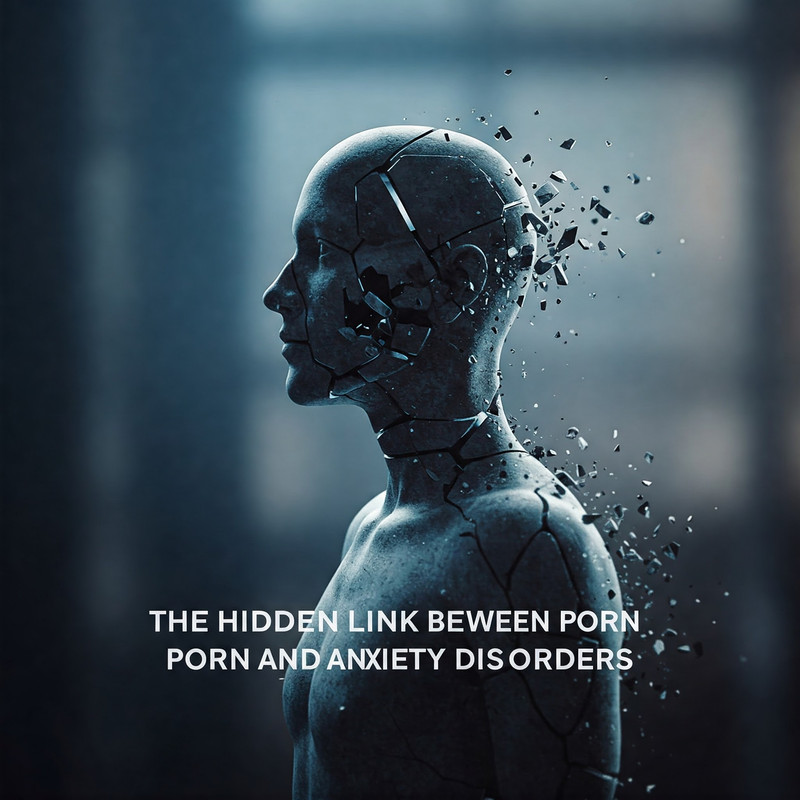The Hidden Link Between Porn and Anxiety Disorders
Anxiety disorders are among the most common mental health conditions globally, impacting millions of individuals in their everyday lives. Meanwhile, pornography consumption has become increasingly normalized in our digital age. Although these two phenomena may appear unrelated, emerging research indicates potential links between adult content use and anxiety symptoms for certain individuals. This relationship is complex, bidirectional, and highly individualized.
Understanding the Relationship
The relationship between adult content consumption and anxiety is complex. For some individuals, it may function as a coping mechanism for underlying stress or anxiety, while for others, certain usage patterns could potentially contribute to increased anxiety symptoms. This complex relationship varies significantly based on individual factors, including:
-
Personal values and beliefs about sexuality
-
Frequency and context of pornography consumption
-
Pre-existing mental health conditions
-
Social support and relationship quality
-
Cultural and religious background
How Anxiety Can Drive Pornography Use
For many individuals, anxiety precedes pornography consumption. People experiencing anxiety often seek relief through activities that provide temporary distraction and pleasure. Pornography can function as:
-
A distraction: For some individuals, the immersive nature of adult content offers a brief distraction from anxiety-inducing thoughts or stressful situations.
-
Self-soothing effect: Engaging with certain types of content can trigger a neurochemical response—such as dopamine release—that may offer temporary relief from anxiety symptoms.
-
Avoidance behavior: Some individuals may turn to digital content as a way to distract themselves or delay addressing situations that cause stress or discomfort.
-
Short-term stress relief: For some individuals, adult content may serve as a short-term stress-relief mechanism during times of increased anxiety.
This pattern creates what psychologists call a "negative reinforcement cycle," where the temporary relief from anxiety reinforces the behaviour, potentially leading to increased frequency of use.
When Pornography May Contribute to Anxiety
While some individuals use pornography to manage anxiety, research suggests that certain patterns of consumption may contribute to anxiety symptoms:
-
Secret behavior and shame: When pornography use conflicts with personal values or occurs in secret, it can generate shame, guilt, and anxiety about discovery.
-
Fear of dependency: Some users become concerned about their ability to control their consumption, creating anxiety about perceived addiction.
-
Social comparison: Exposure to idealized body types and sexual performance in pornography can trigger appearance anxiety and sexual performance concerns.
-
Relationship stress: If pornography use creates conflict in intimate relationships, this can generate significant relationship anxiety.
-
Time displacement: Excessive time spent consuming pornography might reduce engagement in anxiety-reducing activities like exercise, social connection, or mindfulness practices.
The Cycle of Anxiety and Problematic Use
For some individuals, a difficult cycle can emerge—where anxiety leads to frequent use of adult content as a coping mechanism, which may in turn heighten feelings of distress or unease over time.
-
Anxiety symptoms emerge due to various life stressors
-
Pornography provides temporary relief from anxiety
-
Relief reinforces pornography use as a coping strategy
-
For some, increased use leads to shame, relationship problems, or other issues
-
These problems generate more anxiety
-
The cycle continues, potentially intensifying over time
This pattern resembles other anxiety-driven behaviours like substance use or compulsive gaming, where the coping mechanism ultimately compounds the original problem.
Breaking the Cycle: Healthier Approaches
For those caught in this cycle, several approaches may help address both anxiety symptoms and problematic pornography use:
-
Cognitive-behavioral therapy (CBT): Helps identify and challenge unhelpful thought patterns while developing healthier coping strategies for anxiety.
-
Mindfulness practices: Techniques like meditation can help manage anxiety triggers without turning to escape behaviors.
-
Addressing underlying anxiety: Treating the root causes of anxiety often naturally reduces reliance on pornography as a coping mechanism.
-
Open communication: For those in relationships, honest discussion about needs and concerns can reduce shame and relationship anxiety.
-
Values clarification: Understanding one's values around sexuality and relationships helps align behaviors with personal beliefs.
-
Healthy stress management: Developing a diverse toolkit of anxiety management techniques reduces reliance on any single coping mechanism.
A Balanced Perspective
This discussion isn't meant to suggest that all pornography use leads to anxiety or that everyone who consumes pornography will experience negative effects. Many individuals consume pornography without apparent adverse consequences. The relationship between pornography and anxiety becomes concerning primarily when:
-
For some individuals, it may become the primary coping mechanism for managing anxiety.
-
Consumption patterns conflict with personal values
-
Use interferes with relationships or daily functioning
-
The individual feels unable to control their consumption
When to Seek Help
Consider professional support if:
-
Anxiety symptoms persistently interfere with daily life
-
For certain individuals, attempts to modify or reduce their consumption of adult content may prove challenging and not always successful
-
Relationship conflicts around pornography use remain unresolved
-
Feelings of shame or distress about pornography use are overwhelming
Mental health professionals can provide non-judgmental support addressing both anxiety management and developing healthier coping strategies.
Final Thoughts
The relationship between pornography consumption and anxiety represents a complex interplay of psychological, social, and physiological factors that varies significantly between individuals. By understanding these potential connections, people can make more informed choices about their media consumption and develop more effective strategies for managing anxiety. The goal isn't necessarily eliminating pornography but ensuring that one's relationship with it—like any media—supports rather than undermines psychological well-being.

Comments
Post a Comment